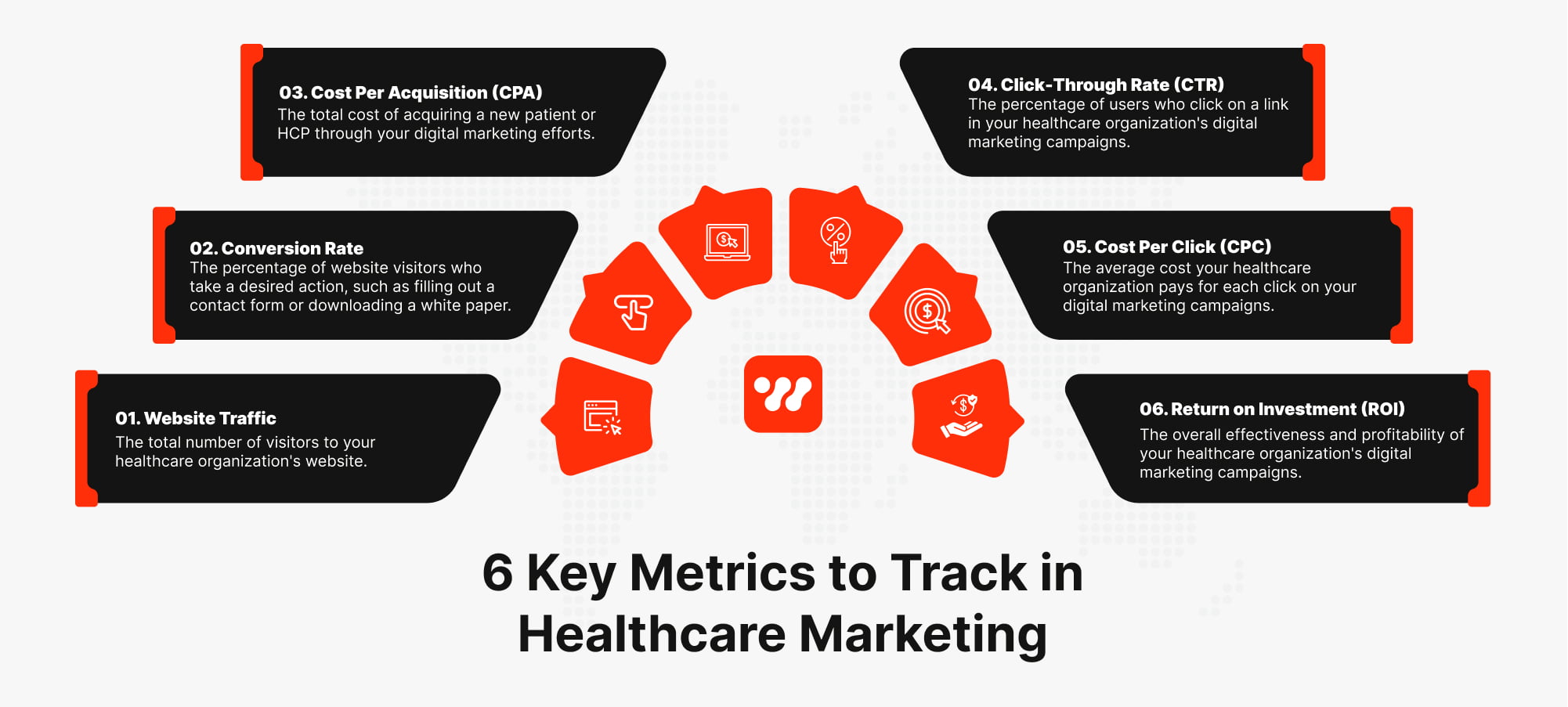
The availability of data and advanced digital analytics tools has further fueled the adoption of digital marketing, allowing organizations to gain valuable insights into patient and HCP behaviors, preferences, and needs. Healthcare digital marketing analytics, in particular, has emerged as a critical discipline for organizations seeking to optimize their online presence, enhance patient and HCP engagement, and deliver better healthcare outcomes.
This comprehensive guide aims to provide healthcare professionals and marketers with a complete overview of healthcare digital marketing analytics, from basic concepts to advanced techniques. We will explore the key metrics and KPIs that matter for patient and HCP engagement, the tools and technologies available for data collection and analysis, and the best practices for leveraging data analytics to optimize your digital marketing campaigns. We will also delve into the ethical and privacy considerations associated with healthcare digital marketing analytics and how organizations can ensure compliance while still deriving actionable insights.
Whether you are a healthcare marketer looking to enhance your organization’s digital marketing efforts or a healthcare provider seeking to improve patient engagement and outcomes, this guide has everything you need to know about healthcare digital marketing analytics.
The healthcare industry has increasingly recognized the value of digital marketing in driving patient engagement and achieving business objectives. However, to effectively leverage digital marketing, organizations must have a clear understanding of healthcare digital marketing analytics, including its basic concepts and terminologies. In this section, we will delve into the fundamental concepts and terminologies of healthcare digital marketing analytics to provide you with a solid foundation for the rest of this guide.
The process of collecting, analyzing, and interpreting data related to patient and HCP engagement with digital marketing channels is known as healthcare digital marketing analytics. This includes social media, email, mobile apps, and websites, among others. The goal of healthcare digital marketing analytics is to gain insights into patient and HCP behaviors, preferences, and needs and then use that information to optimize digital marketing strategies to improve patient engagement and achieve business goals.
Consider a healthcare organization that runs a social media campaign to promote a new service to demonstrate the importance of healthcare digital marketing analytics. Without analytics, the organization would have no idea whether or not the campaign was successful. With analytics, however, the organization can track the number of likes, comments, shares, and clicks on the campaign, and use that information to determine the campaign’s effectiveness and make data-driven decisions to optimize future campaigns.

The success of healthcare digital marketing campaigns can be measured using a variety of metrics and KPIs. Here are some of the most common metrics and KPIs used in healthcare digital marketing analytics:
When determining which metrics and KPIs to use, it is important to consider the organization’s patient and HCP engagement objectives. For example, if the goal is to increase patient engagement with a particular service, conversion rate, and CTR may be the most relevant metrics to track. On the other hand, if the goal is to reach a wider audience, website traffic, and social media engagement may be more important.
Best practices for tracking and measuring metrics and KPIs include setting up Google Analytics or similar tools, setting up goals and events to track conversions, regularly reviewing data, and making data-driven decisions based on the insights gained.
There are three main types of healthcare digital marketing analytics: descriptive, predictive, and prescriptive.

Descriptive analytics provides insights into what happened in the past. Examples of descriptive analytics include website traffic, social media engagement, and email open rates. By analyzing past performance, organizations can gain insights into which digital marketing channels and campaigns are most effective in engaging patients and HCPs.
Predictive analytics uses statistical models and machine learning algorithms to forecast future patient and HCP behaviors and trends. Examples of predictive analytics in healthcare digital marketing include lead scoring, customer segmentation, and propensity modeling. Predictive analytics can be particularly useful in identifying which patients and HCPs are most likely to engage with specific digital marketing channels and campaigns.
Prescriptive analytics goes a step further than descriptive and predictive analytics by recommending specific actions that organizations can take to optimize patient and HCP engagement and outcomes. Prescriptive analytics uses a combination of data analysis and decision-making algorithms to recommend the best course of action for achieving a specific objective. Examples of prescriptive analytics in healthcare digital marketing include marketing automation, dynamic content personalization, and real-time bidding.
To effectively leverage healthcare digital marketing analytics, organizations must first establish a framework that aligns with their patient and HCP engagement objectives. In this section, we will explore the key steps involved in setting up a healthcare digital marketing analytics framework.
The first step in setting up a healthcare digital marketing analytics framework is to identify your organization’s patient and HCP engagement objectives and the KPIs that align with those objectives. For example, if your organization’s objective is to increase patient engagement with a new service, your KPIs may include conversion rate, website traffic, and patient feedback.
It is essential to establish clear and specific objectives and KPIs to guide your digital marketing efforts and measure success. By focusing on specific objectives and KPIs, organizations can optimize their digital marketing campaigns and allocate resources effectively.
The next step is to choose the right healthcare digital marketing analytics tools for patient and HCP engagement. There are numerous tools available that can help organizations collect, analyze, and interpret data related to patient and HCP engagement with digital marketing channels.
Google Analytics is one of the most commonly used tools for healthcare digital marketing analytics. It provides a wealth of information related to website traffic, conversion rates, and user behavior. Other popular tools include SEMrush, Ahrefs, and Moz, which offer insights into search engine optimization and keyword analysis.

When choosing analytics tools, it is important to consider the specific needs of your organization and the types of data you want to collect. It is also essential to ensure that the tools you choose are HIPAA-compliant and align with your organization’s data privacy and security policies.
The final step in setting up a healthcare digital marketing analytics framework is to integrate different data sources for better insights and decision-making. Healthcare organizations can collect data from various sources, such as electronic health records, patient surveys, and social media, to gain a comprehensive understanding of patient and HCP behaviors, preferences, and needs.
Integrating different data sources can help organizations develop more accurate patient and HCP personas and identify the most effective digital marketing channels and campaigns for engaging patients and HCPs. Data integration can also help organizations measure the impact of their digital marketing campaigns on patient and HCP outcomes, such as patient satisfaction, health outcomes, and ROI.
Best practices for integrating different data sources include using data management platforms (DMPs) and customer data platforms (CDPs) to centralize data and make it more accessible for analysis. It is also important to ensure that data is collected and stored in a way that complies with data privacy and security regulations.
The ultimate goal of healthcare digital marketing analytics is to improve patient and HCP engagement and achieve better healthcare outcomes. In this section, we will explore how healthcare organizations can leverage healthcare digital marketing analytics to enhance patient and HCP engagement.
The ability to gain a thorough understanding of patient and HCP behaviors and preferences is one of the most important advantages of healthcare digital marketing analytics. By analyzing patient and HCP engagement with digital marketing channels, healthcare organizations can learn which channels and campaigns are most effective at engaging patients and HCPs, as well as tailor digital marketing messages to individual patients and HCPs based on their preferences, behaviors, and needs.
Healthcare organizations, for example, may use data from patient surveys, electronic health records, and social media analytics to determine which services and treatments are most important to patients, as well as which channels and campaigns are most effective in reaching them.

Another advantage of healthcare digital marketing analytics is the ability to strengthen patient and provider relationships. Healthcare organizations can gain insights into patient and HCP preferences, behaviors, and needs by leveraging healthcare digital marketing analytics, allowing them to create more personalized and relevant digital marketing messages that foster stronger patient and HCP relationships.
Healthcare organizations, for example, could use data from patient surveys and electronic health records to identify patients at risk of developing chronic conditions and proactively reach out to them with personalized digital marketing messages encouraging them to adopt healthy behaviors and engage with their healthcare providers.
Ultimately, the goal of healthcare digital marketing analytics is to improve patient and HCP engagement and achieve better healthcare outcomes. By leveraging healthcare digital marketing analytics to gain insights into patient and HCP behaviors and preferences, healthcare organizations can develop more effective digital marketing campaigns that encourage patients and HCPs to engage with their healthcare providers, adopt healthy behaviors, and achieve better healthcare outcomes.
Healthcare organizations, for example, may use data from patient surveys and electronic health records to identify patients at risk of developing chronic conditions and proactively reach out to them with digital marketing campaigns that promote healthy behaviors like exercise and healthy eating. These campaigns could include personalized digital messages that offer tips and resources for adopting healthy behaviors and encourage patients to work with their healthcare providers to manage their conditions.
Healthcare digital marketing campaigns require continuous analysis and optimization to achieve the desired patient and HCP engagement outcomes. In this section, we will explore how healthcare organizations can analyze and optimize their digital marketing campaigns to improve patient and HCP engagement.
The first step in analyzing healthcare digital marketing campaigns is to track key metrics and KPIs. These metrics and KPIs should align with the organization’s patient and HCP engagement objectives and provide insight into the effectiveness of the digital marketing campaign.
Common metrics and KPIs for healthcare digital marketing campaigns include website traffic, conversion rates, bounce rates, click-through rates, social media engagement, and email marketing open and click-through rates. By tracking these metrics and KPIs, healthcare organizations can identify which channels and campaigns are most effective in engaging patients and HCPs and optimize future campaigns accordingly.

A/B testing involves comparing the performance of two versions of a digital marketing asset, such as an email or landing page, to determine which version is more effective in achieving the desired patient and HCP engagement outcomes. Healthcare organizations can use A/B testing to test different variations of messaging, design, and calls to action to identify the most effective approach for engaging patients and HCPs.
Healthcare organizations may use A/B testing to test different subject lines, email content, and calls to action to determine which approach generates the highest open and click-through rates.
Personalizing digital marketing messages involves tailoring messages to individual patients and HCPs based on their preferences, behaviors, and needs. By personalizing digital marketing messages, healthcare organizations can improve the relevance and effectiveness of their campaigns and increase patient and HCP engagement.
Personalization can take many forms, including using patients’ first names in emails, customizing email content based on patient’s medical history, and tailoring social media posts to individual HCP specialties. By using data from patient surveys, electronic health records, and social media analytics, healthcare organizations can gain insights into patients’ and HCPs’ preferences and needs and develop personalized digital marketing messages that resonate with them.
Marketing automation involves using software and workflows to automate repetitive marketing tasks, such as email marketing, social media posting, and lead nurturing. By automating these tasks, healthcare organizations can save time and resources and deliver more personalized and timely digital marketing messages to patients and HCPs.
Marketing automation can be used by healthcare organizations to send personalized emails to patients based on their medical history, schedule social media posts ahead of time, and nurture leads through a series of automated email messages.
To achieve the full potential of healthcare digital marketing analytics, healthcare organizations should leverage advanced techniques and best practices. In this section, we will explore some of the advanced techniques and best practices for healthcare digital marketing analytics for patients and HCPs.
Predictive analytics involves using historical data and statistical algorithms to make predictions about the future patient and HCP behaviors and preferences. By using predictive analytics in healthcare digital marketing, healthcare organizations can anticipate patient and HCP needs and develop more effective digital marketing campaigns that engage patients and HCPs and achieve better healthcare outcomes.
Predictive analytics can help healthcare organizations identify patients who are at risk of developing chronic conditions and reach out to them with personalized digital marketing messages that encourage them to adopt healthy behaviors and engage with their healthcare providers.
Sentiment analysis involves using natural language processing and machine learning algorithms to analyze patient and HCP feedback and determine their emotions and opinions about healthcare services and treatments. By using sentiment analysis in healthcare digital marketing, healthcare organizations can gain insights into patient and HCP attitudes and develop more effective digital marketing campaigns that resonate with patients and HCPs.
Sentiment analysis can be used by healthcare organizations to analyze patient feedback on social media and create digital marketing campaigns that address patients’ concerns and promote positive healthcare experiences.
Data governance and security are critical considerations in healthcare digital marketing analytics. Healthcare organizations must ensure that patient and HCP data is collected, stored, and used in compliance with relevant data privacy and security regulations, such as HIPAA. Best practices for data governance and security in healthcare digital marketing analytics include conducting regular privacy and security audits, encrypting patient and HCP data, and implementing data access controls to limit data access to authorized personnel only.
Check out IBMs quick explanation of Data Governance in order to easily understand the complex topic.
Collaborative analytics involves bringing together stakeholders from different departments, such as marketing, IT, and clinical operations, to collaborate on healthcare digital marketing analytics initiatives. By using collaborative analytics in healthcare digital marketing, healthcare organizations can gain a more comprehensive understanding of patient and HCP behaviors and preferences and develop more effective digital marketing campaigns that engage patients and HCPs and achieve better healthcare outcomes.
Healthcare organizations may bring together marketing, information technology, and clinical operations teams to analyze patient data and develop digital marketing campaigns that promote preventive care and better healthcare outcomes.
At Webserv, we offer comprehensive healthcare digital marketing analytics services that can help ease the burden of analyzing and optimizing your healthcare digital marketing campaigns. Our experienced team of healthcare digital marketing experts can handle all aspects of your analytics, providing you with real-time insights into patient and HCP behaviors and preferences, and developing data-driven digital marketing strategies that engage patients and HCPs and achieve better healthcare outcomes.
With Webserv handling your healthcare digital marketing analytics, you can focus on what you do best: providing high-quality patient care and improving healthcare outcomes. Our analytics services are fully customizable to meet the unique needs and goals of your healthcare organization, whether you’re a small clinic or a large hospital network.
So why struggle with the complexities of healthcare digital marketing strategy and analytics on your own when you can have the experts at Webserv handle it for you? Book a Meeting today to learn more about how we can help your healthcare organization achieve better healthcare outcomes through innovative and effective digital marketing strategies.
Healthcare digital marketing analytics refers to the process of tracking, measuring, and analyzing the performance of healthcare digital marketing campaigns. This includes tracking website traffic, engagement rates, conversion rates, and other key metrics to optimize the effectiveness of digital marketing campaigns.
Healthcare organizations can benefit from digital marketing analytics in several ways. By analyzing the performance of their digital marketing campaigns, they can gain insights into what is working and what is not. This can help them refine their marketing strategies, improve patient engagement, and ultimately drive more revenue for the organization.
There are several common metrics used in healthcare digital marketing analytics, including website traffic, click-through rates, conversion rates, bounce rates, time on site, and engagement rates. These metrics can provide insights into the effectiveness of digital marketing campaigns and help healthcare organizations optimize their marketing strategies.
There are several tools commonly used in healthcare digital marketing analytics, including Google Analytics, Adobe Analytics, Mixpanel, and HubSpot. These tools allow healthcare organizations to track and analyze key metrics related to their digital marketing campaigns, such as website traffic, engagement rates, and conversion rates.
To ensure they are using digital marketing analytics effectively, healthcare organizations should establish clear goals and key performance indicators (KPIs) for their digital marketing campaigns. They should also regularly track and analyze their performance data, and use these insights to refine and optimize their marketing strategies over time. Finally, they should invest in the right tools and resources to support their digital marketing analytics efforts.